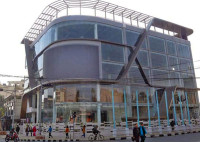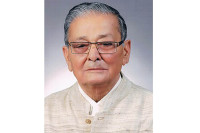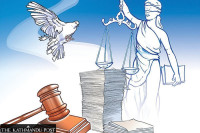National
68 dead in Nepal’s worst domestic air disaster
The crash on Sunday is the second in less than a year, highlighting the country’s consistently poor air safety record, analysts say.
Sangam Prasain
Nepal saw its worst domestic air disaster on Sunday morning when Yeti Airlines flight NYT 691 from Kathmandu to Pokhara crashed a few minutes before landing at the new international airport.
The plane carried 72 persons, including passengers and crew, and 68 had been confirmed dead as of Sunday evening, the country’s civil aviation regulator said in a statement.
Rescue efforts have been suspended for Sunday.
The last communication from the aircraft to the air traffic controller was at 10:50 am from the Seti River Gorge just west of the airport, the Civil Aviation Authority of Nepal stated. “Then it crashed.”
Part of the fuselage of the ATR-72 turboprop could be seen on the hillside while more wreckage was strewn over the Seti River Gorge. A massive crowd had gathered as rescuers were recovering charred bodies from the crash site.
Mobile video footage showed the aircraft bearing registration number 9N-ANC banking steeply to the left a few seconds before crashing.
The Yeti Airlines crash is the first involving an ATR aircraft in Nepal. The model, manufactured by Avions De Transport Regional (ATR), a joint venture of France and Italy, was introduced in Nepal in July 2010.
This is Nepal's third deadliest air accident and the worst in domestic aviation. More than four million passengers fly domestic carriers annually.
The disaster is the second in under a year, highlighting the country's consistently poor air safety record, analysts said.
Among the passengers were three infants, three children and 62 adults. According to the Civil Aviation Authority of Nepal, the passengers included 53 Nepalis, five Indians, four Russians, two Koreans, one Irish, one Australian, one Argentinian, and one French.
A five-member probe committee has been formed to investigate the disaster. Officials had no further information.
“The probe committee will dig out the truth. There is something wrong here,” said aviation analyst Hemant Arjyal.
“This is a terrible disaster. If a plane goes down in clear weather for no apparent reason, there is obviously something wrong. We have to wait for the probe report.”
The Kathmandu-Pokhara flight is a 25-minute hop. Analysts say a whole bunch of questions remain unanswered.
“Obviously, we are surprised. That’s a shocking crash,” said an ATR instructor pilot who flies to Pokhara regularly.
“It can be anything. Bird strike, engine failure or something else,” he told the Post, asking not to be identified as the investigation had already started. “Whatever the reason might be, the issue is serious.”
The runway of Pokhara International Airport is 45 metres wide and 2,500 metres long, and its designation is 12-30.
The ill-fated plane commanded by Captain Kamal KC, an instructor pilot, made the first contact with Pokhara control tower from nearly 110 kilometres away.
“The weather was clear. We allocated Runway 30 which is the eastern end. Everything was fine,” said Anup Joshi, spokesperson for Pokhara International Airport. He added that no problems had been reported.
The flight captain later asked for permission to switch to Runway 12 which is the western end. “We were not sure why. Permission was granted, and accordingly, the aircraft started its descent,” said Joshi who is also a senior air traffic controller.
According to Nepal’s civil aviation body, 914 people have died in air crashes in the country since the first disaster was recorded in August 1955. The Yeti Airlines tragedy in Pokhara on Sunday is the 104th crash in Nepali skies and third biggest in terms of casualties.
The first big air accident occurred on September 28, 1992 when an Airbus A310 belonging to Pakistan International Airlines slammed into a hillside at Bhattedanda near Kathmandu Valley, killing 167 people on board.
Before that, on July 31, 1992, an Airbus A310 of Thai Airways crashed in Ghyangphedi, killing 113 on board.
The Post reported in August last year that aeroplane pilots were finding out about bird hazards in Pokhara the hard way.
The tourist hotspot lies between two rivers, the Bijayapur and the Seti, which makes it a perfect habitat for birds. Excellent for sightseers, of course, but a terror for pilots.
Nepal took out a $215.96 million soft loan from China EXIM Bank in March 2016 to build the international airport in Pokhara. The project was implemented on an engineering procurement and construction model.
Some experts told the Post that the civil aviation regulator did not follow safety protocols and allowed the plane to land from the western end of the runway.
“When the civil aviation regulator is focused on airport development and expanding business, the nation and public have to pay the cost,” said one retired chief of the civil aviation body.
“For your information, the airport was hastily inaugurated and operated without adequate preparations to meet the January 1 project deadline. Flight calibration, which tests all pieces of equipment at the new airport, has not recommended landing from the west.”
He added, “The flight procedure has not been published. Airlines have very little information about airport procedures and data.”
Experts have also pointed out some serious lapses at the new airport.
“An evaluation as required by the ‘safety management system’ was not carried out, neither by the civil aviation regulator, as a service provider of the airport, nor by the airlines,” the former chief said.
“The civil aviation body has misused its regulator role to operate the airport neglecting safety requirements. This is a serious crime and mass murder, and subject to criminal investigation.”
Officials say that the flight procedure and flight data are not available as they have not been published in the Aeronautical Information Publication yet.

A senior captain of Buddha Air, who also flies an ATR-72, admits that flight data is not available, but it is not related to flight operation under visual flight rules (VFR), a set of rules pilots use to fly using visual references outside the cockpit.
“For VFR flights, airlines develop their own rules and procedures. We, however, are not allowed to go to the west end of the runway under instrument flight rules (IFR), guided by the instruments in the cockpit.”
But the pilot said the aircraft abruptly made a tilt which shows that there were serious hitches. “As a result of the tilt, the plane stalled and plunged,” he said.
“There was no black magic. It looks like the plane suffered a serious technical glitch. The probe report will tell this.”
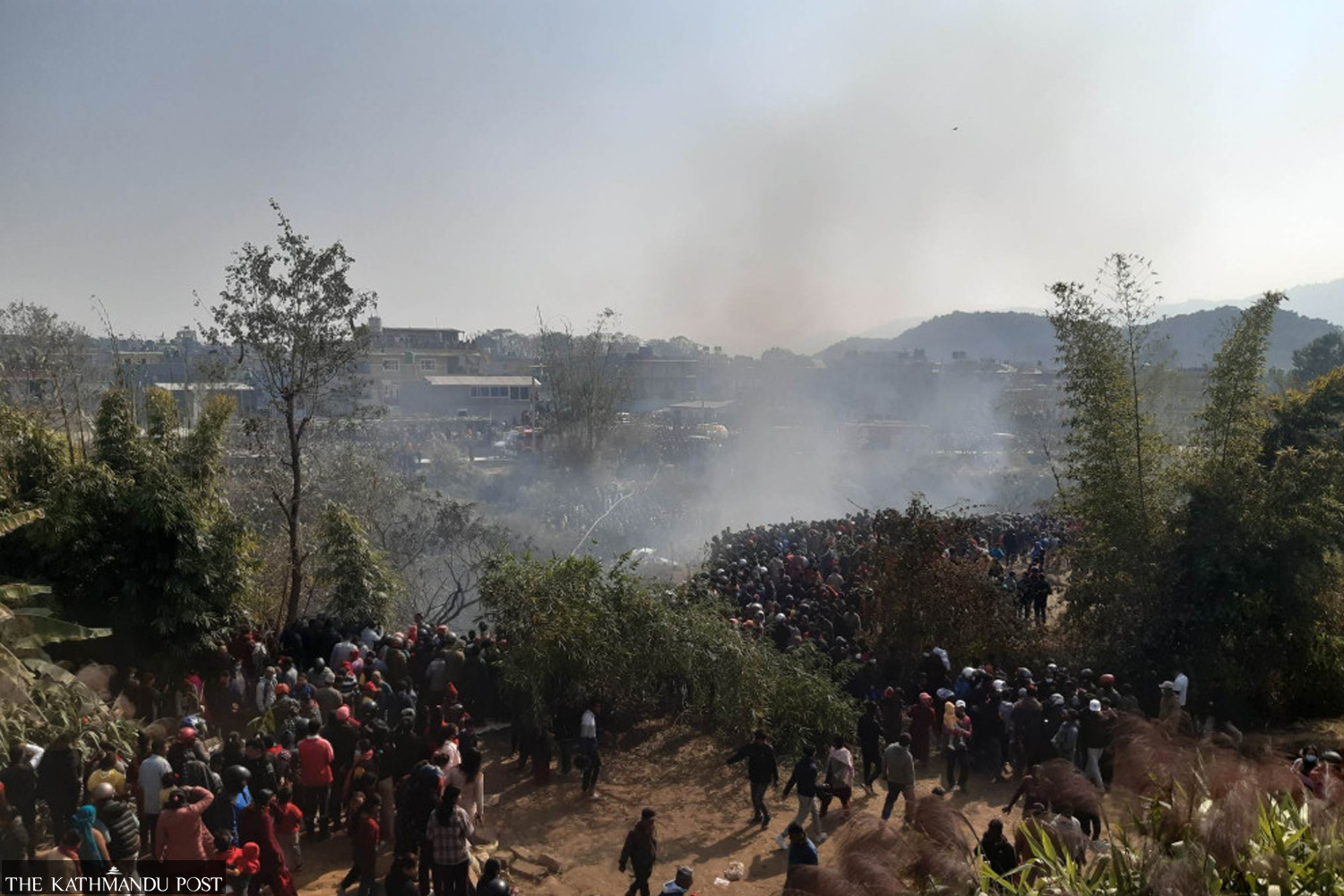
President Bidya Devi Bhandari tweeted, “I am speechless about the crash of Yeti Airlines' ATR-72 aircraft. I convey my heartfelt condolences to the passengers and the crew members who lost their lives.”
Aviation analyst Arjyal says the problem lies in Nepal’s system. “Nepal has been in the bad books of the European Union for the last decade. The message is clear, if you don’t improve, you will face the consequences.”
Global aviation watchdogs have questioned the civil aviation body’s dual role and urged Nepal to split the organisation into two entities—service provider and regulator—to enhance the safety of flyers. But the government has shown no interest in doing so, and Nepal's aviation industry is suffering the consequences.
Several unnamed experts told the Post that the civil aviation body has been misusing its authority, but no one wants to speak against it for fear of retribution.
“Obviously, the government is not bothered to see what’s going on in the civil aviation system,” said Sanjiv Gautam, former director general of the Civil Aviation Authority of Nepal. “It’s a shame that one government tables civil aviation bills and another government withdraws them.”
Nepali experts say the civil aviation body has offered no strong logic why it doesn’t want this functional separation.
On March 1, 2022, the Parliament Secretariat included two aviation bills in the agenda for a meeting of the lower house scheduled for March 2.
But on March 2, the then tourism minister Prem Ale suddenly requested the Parliament Secretariat to hold back the bills, explaining that some employees of the aviation regulator were opposed to the planned fragmentation of their office.
Parliament was subsequently prorogued, and the proposed pieces of legislation were once again put in deep storage.
In August, the then tourism minister Jeevan Ram Shrestha said that Nepal would not immediately accept the condition the European Commission has put forward to separate Nepal's civil aviation into regulatory and service-providing organisations.
United Nations aviation watchdog International Civil Aviation Organisation has also formally asked Nepal to split the civil aviation body into two entities—service provider and regulator. The separation is a crucial organisational reform agenda which has been a work in progress for the last one and a half decades.

The civil aviation body has not made the report public.
“Money making seems to be more important than passenger safety. Furthermore, this will also impact our tourism sector and compound Nepal's chequered aviation history,” lawmaker and Nepali Congress leader Udaya Shumsher Rana tweeted.
“Parliament needs to conduct serious deliberation on fast-tracking the two bills regarding air safety regulations—the Civil Aviation Authority of Nepal and the Air Service Authority of Nepal Bill. CAAN urgently needs to split the civil aviation body into two entities—service provider & regulator.”
The existing system allows the director general of the Civil Aviation Authority to issue tenders for multi-billion-dollar projects.
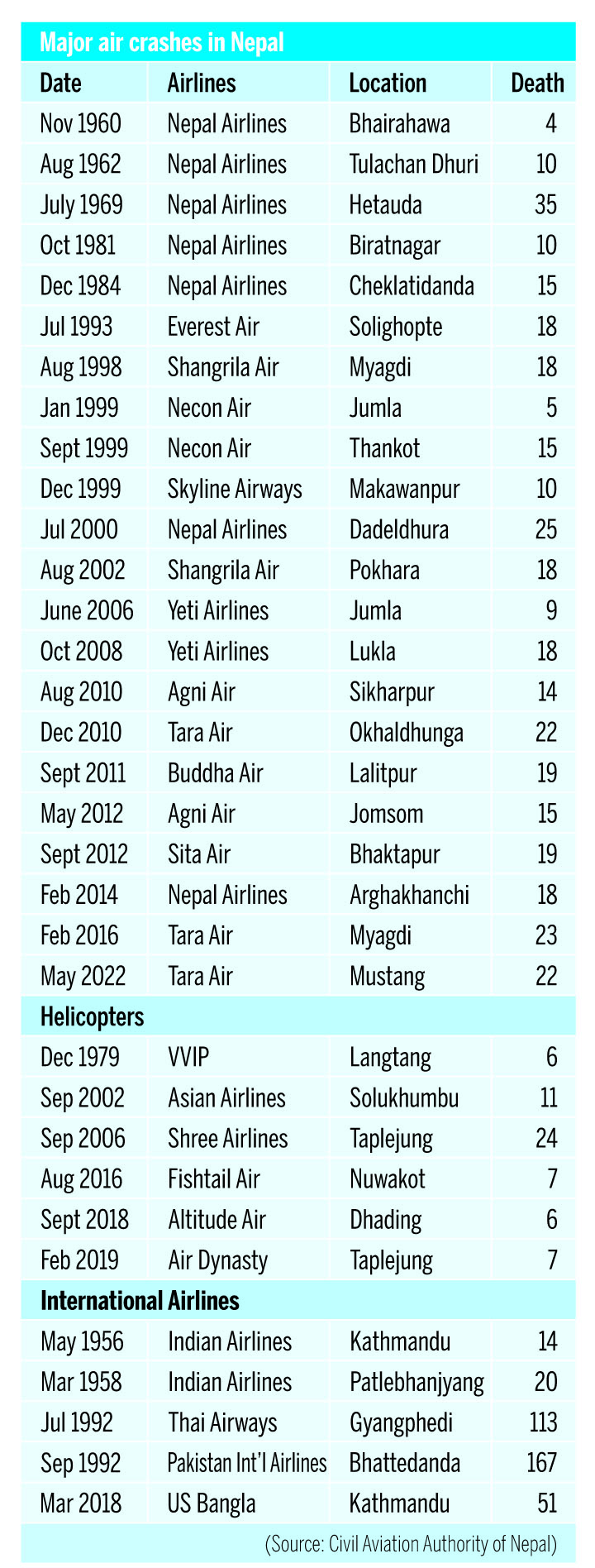
The same person also has the plum job of overseeing compliance with the project and the aviation regulations governing the issuance of licences to airlines and crews.
“No one wants to lose this scope and power. That’s why, despite intense pressure, it has become hard to split the civil aviation body for a long time,” insiders say.
Following the September 2012 crash of Sita Air Flight 601 at the Manohara River which killed 19 people, including seven British citizens, the European Commission imposed a blanket ban on Nepali airlines from flying into the 27-nation bloc in December 2013.
The European Commission has said that there are no grounds for amending the list of air carriers which are subject to an operating ban within the Union with respect to air carriers from Nepal.
“The problem lies in the aviation system, not in the planes or pilots,” said Arjyal. “The government is not serious. Really not serious to improve safety despite the multiple requests of global aviation watchdogs.”




 15.12°C Kathmandu
15.12°C Kathmandu

